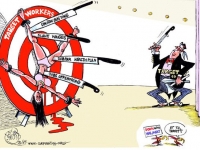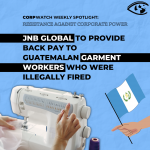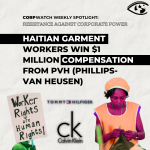Target: Wal-Mart Lite

Shopping in a Target store, you know you're not in Wal-Mart. But the differences may be mostly skin deep.
Targets are spaciously laid out and full of attractive displays and promotions. While many people associate Wal-Mart with low-income, rural communities perhaps dominated by a prison or power plant, life-size photos throughout Target stores remind you that their customers are a lively, beautiful cast of multi-cultural hipsters.
"Their image is more upscale, more urban and sophisticated, sort of a wannabe Pottery Barn," said Victoria Cervantes, a hospital administrator and documentary-maker in Chicago who regularly shops at Target. "I'm not sure if their customers really are more upscale. But that's the image they're going for. They have a very good PR campaign."
In contrast to this image, however, critics say that in terms of wages and benefits, working conditions, sweatshop-style foreign suppliers, and effects on local retail communities, big box Target stores are very much like Wal-Mart, just in a prettier package.
Of more than 1,400 Target stores employing more than 300,000 people nationwide, not one has a union. Employees at various stores say an anti-union message and video is part of the new-employee orientation. At stores in the Twin Cities, where Target is headquartered, the United Food and Commercial Workers (UFCW) union Local 789 has been trying for several years to help Target employees organize, with little luck.
"People ask what the difference between Wal-Mart and Target is," said UFCW organizer Bernie Hesse. "Nothing, except that Wal-Mart is six times bigger. The wages start at $7.25 to $7.50 an hour [at Target]. They'll say that's a competitive wage, but they can't say it's a living wage. We know a lot of their managers are telling people, 'If we find out you're involved in organizing a union you'll get fired.'"
Wal-Mart has about 3,800 stores nationwide and another 2,600 worldwide, employing about 1.6 million people. Target plans to open at least 600 more stores by 2010, for a total of about 2,000 in 47 states. Like Wal-Mart, a typical Target sells a wide range of consumer goods including clothing, household items, office supplies, toys, sports equipment, furniture, art, and electronics; and the stores often have photo laboratories and pharmacies. About 160 SuperTargets nationwide also sell "upscale" groceries, as the company's website describes them, and often contain banks, Starbucks, and Pizza Hut Express outlets. Total revenue was up 12.3 percent in 2005 - $52.6 billion compared to $46.8 billion in 2004.
Wage Slaves
A survey by the UFCW found that starting wages are similar in Targets and Wal-Marts -- possibly higher overall at Wal-Marts - and that Target benefits packages are often harder to qualify for and less comprehensive. (Target's media relations department refused to comment on its wages and benefits policies; individual wages and benefits policies are not included in their annual report.)
"We know that Target and Wal-Mart are constantly checking each other out and seeing how cheap they can get by," says a UFCW statement on the website Targetunion.org, urging Target employees around the country to post their wages.
A Target employee who asked that his name and store location be kept secret said he can barely make ends meet on his salary of $8.40 an hour.
"After three years, I have received less than $1 an hour in raises. I started at $7.65," said the worker, adding that he does love his job because of camaraderie with his co-workers. "We are never compensated and rarely even recognized for meeting our goals."
The starting wage he describes would put a single parent with two kids working full time at Target just slightly above the poverty line; someone with more children or working fewer hours would fall below the poverty line.
Compare that to Target CEO Robert Ulrich, who earned $23.1 million in 2005, according to Forbes, making him the second-highest paid CEO in the retail sector. That's more than 1300 times as much as the worker we spoke to.
Sweat on the Racks?
Meanwhile a glance at labels on a few racks of stylish $20 cardigans and capri pants shows that, like Wal-Mart and most major clothing retailers, Target itself sources its products in India, Indonesia, Guatemala, Mexico, Bangladesh, Kenya, Sri Lanka, the Philippines, Vietnam, Cambodia and other low-wage, developing countries.
In October 2005 representatives of a Mexican labor federation protested outside a Bronx Target to call attention to alleged child labor and illegal worker lockouts at a Mexican factory that supplies the store's Halloween costumes.
"The way the global garment industry is, there are so few factories that respect workers' rights that there is no way Target gets its clothes from workplaces where workers' rights are being respected," said Allie Robbins, national organizer of the group United Students Against Sweatshops.
Race to the Bottom
Target doesn't differ from most major clothing vendors; you usually have to seek out small specialty companies to find union-made, American-made textiles. But as one of the country's major retailers, Target is an industry leader, fostering and profiting from the U.S.'s general culture of consumerism: We buy, buy, buy at ever lower prices in a market system sustained by very low-paid, non-union workforces in impoverished countries.
Even as American consumerism thrives, however, there is growing public awareness and critique of the problems it spawns. Wal-Mart is becoming a lightning rod for the public's increasing dissatisfaction and animosity. A recent study by the University of Massachusetts at Lowell showed that 63 percent of people would oppose a Wal-Mart opening in their community. Groups such as Wal-Mart Watch, several documentarians have harshly critiqued Wal-Mart's working conditions and its effects on communities and international labor standards.
But somehow, perhaps because of its relative small size compared to Wal-Mart, Target has largely avoided negative publicity.
In fact, it benefits from anti-Wal-Mart anger, a fact that isn't lost on company officials.
Media reports describe Target executives booing and hissing at a Wal-Mart logo during sales meetings and calling it the "evil empire." While communities often fight tooth and nail against new Wal-Marts, residents usually welcome Targets, as local governments offer the corporation generous tax breaks and subsidies to locate in their area.
That is what happened last fall in West St. Paul, Minn., where a new Target reaped $731,000 in local tax breaks, while 30 miles away, Ham Lake was fighting Wal-Mart's efforts to open a superstore. The Target in downtown Minneapolis received $68 million in public subsidies, according to the Star Tribune newspaper. In Chicago in 2004, a city-wide coalition formed to oppose two proposed Wal-Marts and the fight roiled the city council for months. Meanwhile at least three new Target stores have been built in the metro area in the last several years.
Target definitely works hard on its image. Last summer it became the first company to sponsor an entire issue of The New Yorker, with 17 pages of ads. With a 2005 advertising budget of $1.028 billion, it regularly takes out full page ads in major daily papers and magazines, promoting the company's products, and sophisticated image as well as its charity work. The company's website says that 96 percent of Americans recognize the Target logo, "more than the Swoosh or Apple." Unlike Wal-Mart's low-budget, cluttered decor, Target sports artsy, larger-than-life photos of everything from cleaning products to desserts to women in lingerie. It is the exclusive marketer of specialty items such as the Roots "retro-futurism" official gear for the 2006 Winter Olympics. Target's website notes that its average consumer has a median household income of $55,000, and 43 percent have completed college.
"It's like they're trying to be Marshall Fields or something," said Chicago high school student Stephanie Evans, shopping for a bikini for spring break. "But it's really the same things as at Wal-Mart, just at higher prices."
The first Target discount store opened in Roseville, Minnesota, a suburb of St. Paul, in 1962. It was run by the Dayton Company, which originated in 1902 with a retail store called Goodfellows owned by George Dayton in Minneapolis. Along with the discount stores, Target Corp. runs Target Financial Services, which manages the Target REDcard credit card.
Target: We Train the FBI
Perhaps Target's oddest singularity is the fact that it boasts one of the nation's top forensics labs at its company headquarters. A product of its efforts to stop shoplifting and property destruction at its stores, its mastery of surveillance and investigative technology and strategy is now eagerly subscribed to by law enforcement agencies nationwide, including the FBI. The company provides training for police and federal agents on investigation and prevention of everything from arson and robbery to smuggling.
Target does more proportionately for the community in the form of community grants and charity than Wal-Mart does, and spends considerably less boating about it. According to the company website, which says Target donates more than $2 million a week to local and national non-profit organizations. The company gives grants of $1,000 to $3,000 to community organizations, and shoppers can donate 1 percent of Target REDcard charges to a local school. The website says more than $154 million has been donated to schools since 1997. The company also runs Target House, a luxury residential facility in Memphis where families can stay while their seriously ill children are treated at a nearby medical center.
In comparison, Wal-Mart, with revenue of $288 billion in 2005, donated $200 million (or 7/100ths of a percent) to charities and organizations in 2005, according to its web site.
While many customers and employees praise Target's charity efforts, critics counter that the company would have more positive impact on communities by providing living wage, stable jobs to local residents.
Following the general trend in retail and the U.S. job market as a whole, Target relies on part-time workers. This schedule may work well for some students and retired people, but it contributes to a dearth of full-time, fully benefitted, stable employment - especially in communities reeling from the store's impact on small local businesses.
"If I needed a full time job I couldn't afford to work here," said "Rosa" a 57-year-old who works part time at a St. Paul Target near her house. (Her name has been changed because she fears retribution.) "It starts at $7.50 an hour and you only get a 50-cent raise once a year. So how long will it take you to even get to $10 an hour! You can't live on that."
Diversity Dilemma
Target's website says diversity is a core value for employees and customers. It says Target is above national averages in employing minorities, both in the overall workforce (21 percent) and managerial positions (38 percent).
But that may depend on the store. Hesse said that some of the many Somalis refugees employed in the Twin Cities stores complain about cultural insensitivity and discrimination.
"Entry level management people just don't know how to handle it, they seem to be insensitive to immigrant workers," said Hesse. "In one store, there's a lot of friction between managers and Somali workers. They hire these young white boys as managers, and then they run a crew of Somalis with a very condescending attitude."
An African-American employee at the flagship Roseville, Minn. store (who asked that her name not be used for fear of retribution), said she feels as if she constantly suffers racial discrimination. She said there are no black supervisors on the overnight shift she works. "There are a lot of Somalis working on the overnight shift, but no Somali team leader." She said she is tired of young white "team leaders" repeatedly telling her to work faster or do things differently.
"It's the same conversation over and over," said the middle-aged woman. "They treat us like we're kids. And they'll approach you in front of other crew members, not in the office or somewhere private."
She thinks she was unfairly given a document from management saying she needed to increase her work speed.
"I feel like I was discriminated against because I'm black," she said. "I talked to white co-workers who I was working side by side with, and I could see I was working just as fast as them. I asked them if they had to sign the paper [from management] saying they were too slow and they did not. The majority who got the "guidance" slips were Somali or African-American like myself."
Beat the Clock
Workers generally complain about a pressurized and patronizing work atmosphere where they are constantly pressed to work harder and faster and at the same time to act cheery and invested in the store's success. The company's website boasts that workers will respond with "cheetah-like" speed within 60 seconds to customer calls on the red phones throughout the store.
Rosa said employees are constantly exhorted to get shoppers to sign up for Target REDcards; some stores have weekly quotas. "They'll have little employee promotions, it's so ridiculous, you'll get candy or a liter of pop if you get two people to sign up," she said.
She said the store is generally understaffed and workers are expected to do numerous jobs at the same time.
"You're running around, feeling like you're being pulled in every direction," she said. "There's never enough people on the sales floor. You're getting calls to come up to the cash register, to do pulls [of merchandise] in the back room, to deal with returns at guest services, all at once. And the whole time you're constantly picking up and folding stuff, getting things off the floor. At my age it's a really hard day, on your feet the whole time on these linoleum floors. I'm aching when I get home. I have to take Ibuprofen just to be able to sleep."
John Hayden had a similar experience working in a Target distribution center near his home in Oconomowoc, Wisc. After quitting his Target job in 2002, he was diagnosed with a hernia which he blames on lifting up to 700 boxes a day.
"It was hard work," said Hayden, who was in his late 50s at the time. "We never produced enough to keep the middle managers happy. I think they plan it that way - they always want more."
Could it Be Different?
In today's market, could retail really be any different? Fair labor advocates think so. Hesse notes that in several unionized grocery stores in the Twin Cities, hourly wages hover around $13 to $17 an hour, roughly double Target's. Now SuperTarget's sale of groceries threatens the survival of union grocery stores.
Even other major big box retailers have managed to pay significantly higher wages and achieve higher employee retention. The prices at Costco Wholesale Corp., the nation's fifth largest retailer, are competitive with those at Target and Wal-Mart, but it pays full-time employees an average of around $16 an hour along with generous health benefits.
Costco pulls this off by offering fewer brands of each item, keeping infrastructure costs low and forgoing advertising; and the company also benefits financially from low employee turnover. Labor advocates also note that The Container Store is known for decent wages and good working conditions.
"We've turned into a nation of consumers, not citizens," said Hesse. "We need to make retailers and employers bring back the old social contract where if you work hard and give them full time, they have to treat you with some degree of dignity and pay you enough that you don't need to worry about your basic needs all the time."
- 184 Labor



